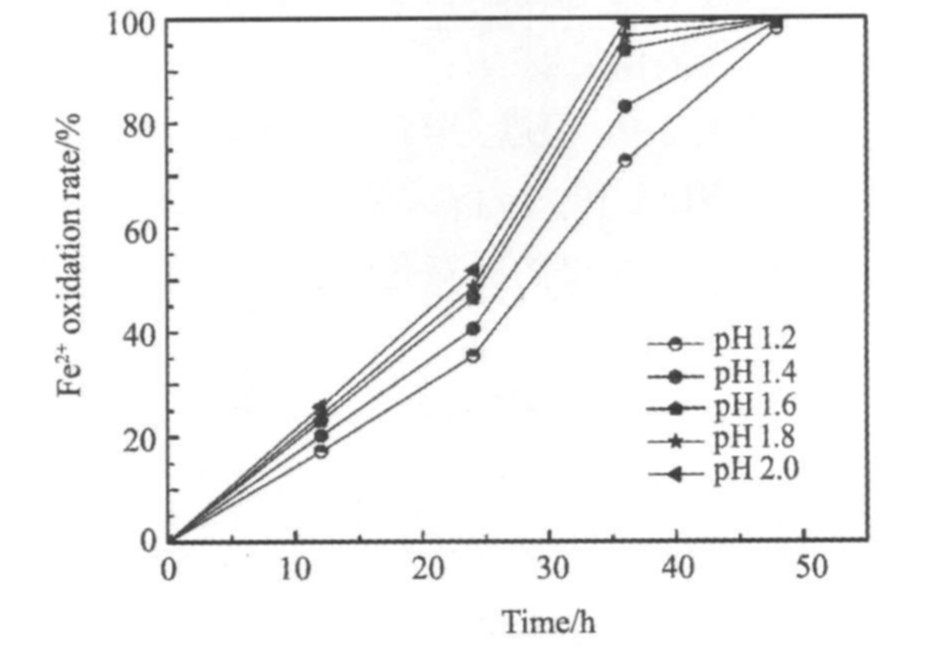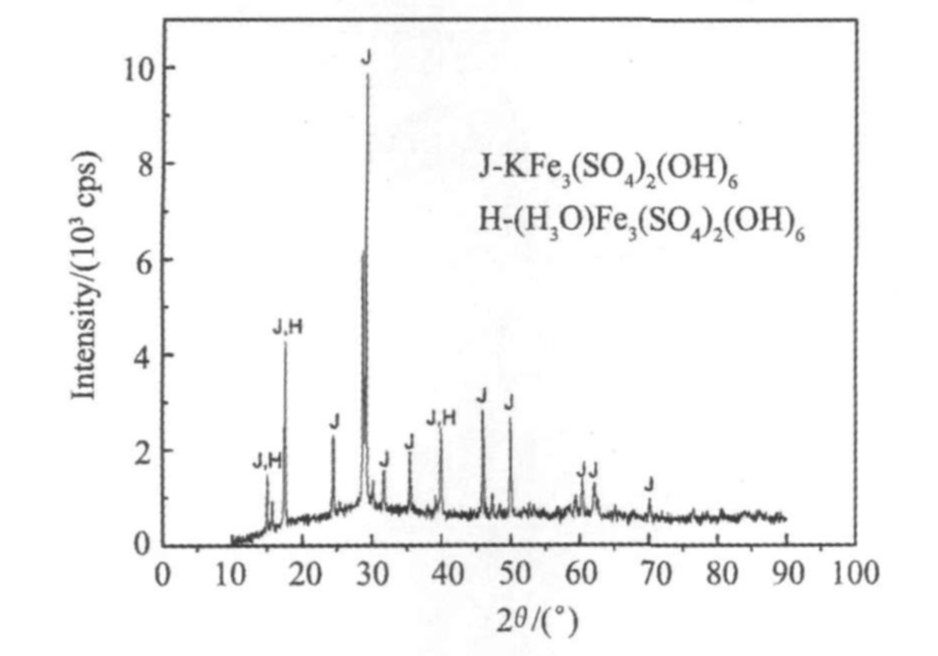复杂微生物浸出液生物成矾法净化除铁的研究
北京有色金属研究总院生物冶金国家工程实验室
摘 要:
针对低品位矿石生物浸出液中铁含量高而有价金属含量低的特点,研究低温、低pH条件下微生物成矾除铁方法,考察了温度、pH值、菌液接种量、时间等主要因素对微生物氧化及铁矾形成的影响规律,并采用正交实验对微生物成矾除铁规律进行多因素影响分析。结果表明:在生物氧化过程中,亚铁含量为9.46 g·L-1的料液,在pH范围为1.4~2.0,温度范围为30~40℃时,36 h细菌将亚铁氧化完全,细菌氧化亚铁的效果较好;在生物成矾除铁过程中,当pH为2,温度为45℃,菌液接种量为15%,反应时间为10 d时,除铁率达到99.97%,除铁后料液含铁0.015 g·L-1;通过正交实验,确定了影响生物成矾法除铁的主次因素顺序分别为反应时间、接种量、总铁浓度,最优水平组合为:总铁浓度50 g·L-1,接种量20%,反应时间10 d,在此最优组合条件下,沉淀除铁率高达99.95%,实现了低温、低pH条件下微生物成矾除铁,为微生物浸出液的低成本、高效净化除铁提供了一条新途径。
关键词:
中图分类号: TF111.3;TF18
作者简介:刘美荣(1985-),女,内蒙古人,硕士研究生;研究方向:湿法冶金;周桂英(E-mail:zhouguiying2001@163.com);
收稿日期:2011-09-01
基金:“973”国家重点基础研究发展计划课题(2010CB630906);
Iron Purification by Formation of Jarosite in Complex Bioleaching Solution
Abstract:
The characteristic of bioleaching solution with high concentration of Fe and low concentration of valuable metals,the separation of Fe by the formation of jarosite with bacteria at low temperature and low pH were studied.The factors,such as pH,temperature,inoculate quantity and time,which affected the separation of Fe from solvent system consisting of sulphate were investigated.And the factors that affected the formation of jarosite were studied by the orthogonal test.The experimental results showed that,in the biological oxidation process,for the solution containing ferrous Fe 9.46 g · L-1,in the pH range of 1.42.0,temperature range of 3040 ℃,the oxidation of ferrous iron by bacteria was completed after 36 h,and the effect of bacterial oxidation of ferrous iron was better.In the process of iron removal by the formation of jarosite with bacteria,at pH of 2,temperature of 45 ℃,inoculate quantity of 15%,time of 10 d,the iron removal rate was 99.97% with low residual iron concentration of 0.015 g · L-1.Through orthogonal test,the primary and secondary factors that effected the jarosite precipitation were confirmed as time,inoculate quantity and the concentration of iron.The optimal combination of factors was total Fe concentration of 50 g · L-1,inoculate quantity of 20%,time of 10 d.With these optimal factors,the iron removal rate was 99.95%.It was realized to remove iron by biological purification under the conditions of low temperature and low pH values,providing a new way to purify complex biological leaching solution.
Keyword:
bioleaching solution;low pH;biological formation of jarosite;iron separation;
Received: 2011-09-01
湿法冶金过程中铁的控制是一个普遍性问题, 随着湿法冶金工业的发展, 种类繁多的湿法工艺流程不断产生, 因此适应工艺特点的除铁方法随之不断产生。 工业上常用的除铁方法有化学法和萃取法, 萃取法除铁普遍存在反萃困难、 速度慢等缺点, 并容易造成有机相中残留铁的积累, 影响有机相的正常使用。 化学法除铁的各种方法比较如表1所示
表1 化学法除铁的各种方法比较
Table 1 Comparison of chemical method for iron removal methods
| Type | Scope of application | Main form of sediment |
Conditions |
|||
| Temperature/ ℃ |
Pressure | Iron valence state |
Acidity | |||
| Jarosite method | Total iron and acidity are high | MFe3(SO4)2(OH)6 | 95~100 | Atmospheric pressure | Fe3+ | pH 1.5~2.0 |
Goethite method |
Fe3+and pH are high | FeOOH | ~80 | Atmospheric pressure | Fe2+ | pH 3.5~4.5 |
Hematite method |
Iron and acidity are high | Fe2O3 | 150~160 | High pressure | Fe2+ | pH 4.0~4.5 |
Neutralization method |
Total iron and acidity are low | Fe(OH)3 | 60~80 | Atmospheric pressure | Fe3+ | pH 3.5~4.5 |
黄钾铁矾法沉淀除铁, 杂质铁易于沉淀、 洗涤和过滤, 但缺点是渣量大, 硫酸消耗较多; 针铁矿法的优点是流程短、 设备简单、 铁渣过滤性能好, 但是针铁矿法生产率相对较低, 能耗大; 赤铁矿法除铁铁渣量少, 含铁高, 但是该法在高温高压条件下进行, 能耗高; 一般中和法, 操作控制相对容易, 反应温度低, 在常压下进行, 需要设备相对简单, 但碱耗高, 铁渣中有价金属夹带高, 过滤性能较差
本文针对吉林白山铜镍钴硫化矿复杂生物浸出液的特点: 浸出液pH低, 约为1.2~1.8; 有价金属含量低, 而作为杂质元素存在的铁含量高。 本实验采用低温、 低pH值、 有菌条件下生物成矾法除铁。 该方法的主要优点是: (1) 有菌条件下形成的黄钾铁矾, 结晶状态好, 且分散性和过滤洗涤性能较好
1 实 验
1.1 材料和仪器
实验所用细菌是从吉林白山铜镍钴硫化矿酸性矿坑水中分离筛选的氧化亚铁硫杆菌(thiobacillus ferrooxidans)、 氧化硫硫杆菌(thiobacillus thiooxidans)和氧化亚铁微螺菌(leptospirillum ferrooxidans)的混合菌。
实验用9 K培养基成分为(单位: (g·L-1)): (NH4)2SO4, 3.0; K2HPO4·3H2O, 0.5; KCl, 0.1; MgSO4·7H2O, 0.5; Ca(NO3)2·2H2O, 0.01; FeSO4·7H2O, 9.0。
实验所用的主要仪器包括PHSJ- 3F数显型酸度计, HZ- 9311K微生物培养箱, Nikon 50i相差显微镜, 5804R台式高速冷冻离心机。
1.2 实验方法
1.2.1 模拟溶液的制备
实验所用模拟溶液是根据吉林白山铜镍钴硫化矿复杂生物浸出液中亚铁浓度和总铁浓度进行配制, 所配溶液为Fe2+浓度9.46 g·L-1, 总Fe浓度12.43 g·L-1。
1.2.2 实验步骤
菌种培养: 采用9 K培养基, 初始pH 1.80~2.00, 接种量5%(接入菌液的体积: 菌液与料液的总体积), 温度30 ℃, 摇床转速150 (r·min-1), 培养时间2~3 d。 利用相差显微镜观察细菌的生长状况, 利用台式高速冷冻离心机对菌液进行离心, 使菌种浓度达1×107 cell·ml-1。
生物成矾法除铁实验: 利用300 ml的锥形瓶, 每个瓶中加入140 ml配制的溶液, 瓶中pH值范围为1.2~2.0, 温度范围为30~45 ℃, 将培养好的菌液过滤除去沉淀物后, 按一定的接种量接入配制的溶液, 每个瓶中的pH通过逐滴加入稀H2SO4或1 mol·L-1的KOH调节。 然后将锥形瓶放入摇床中, 摇床温度设置为30 ℃, 转速为160 r·min-1。 测定瓶中亚铁浓度的变化, 亚铁完全氧化后, 向每个瓶中加入理论量的0.5 mol·L-1的K2SO4溶液, 然后测定每个瓶中总铁浓度的变化。
2 结果与讨论
2.1 亚铁细菌氧化条件实验
细菌氧化亚铁离子的总反应为
在细菌氧化亚铁离子的过程中, 有几个因素起着关键作用
2.1.1 pH值对细菌氧化亚铁的影响
结合生物浸出液的特点, 选取pH值范围为1.2~2.0, 间隔为0.2, 温度为30 ℃的条件, 考察细菌对Fe2+氧化的情况。 细菌浓度约为1×107 cell·ml-1的细菌, 接种量为10%。 不同pH值条件下, 亚铁氧化率随时间的变化结果如图1所示。
实验表明, 48 h之后, 亚铁基本被氧化完全, 且随着pH的升高, 氧化效果逐渐提高。 在pH范围为1.4~2.0时, 48 h之后亚铁基本氧化完全, 所以将此pH值范围定为最佳pH范围, 这一范围与细菌的最佳接种pH范围相吻合。
从图1可以看出, pH范围为1.4~2.0, 温度为30 ℃的条件下, 72 h后, 细菌将大部分的Fe2+氧化为Fe3+, 细菌的氧化率接近100%。
2.1.2 温度对细菌氧化亚铁的影响
在最佳pH范围为1.4~2.0内, 考察不同温度30, 35, 40, 45 ℃条件下, 细菌对亚铁氧化效果的影响。 通过实验能够得到细菌氧化亚铁的最佳温度范围。 不同温度条件下亚铁氧化率随时间的变化情况如图2所示。
实验表明, 在最佳pH范围内, 在细菌的作用下, 随着时间的延长, Fe2+的氧化速率逐渐上升, Fe2+的氧化速率在30~40 ℃时比在45 ℃时要快, 该结果和有关该混合菌生长的最佳温度范围的报道一致。
图1 不同pH条件下Fe2+氧化率随时间的变化
Fig.1 Change of oxidation rate of Fe2+ with time under condition of different pH
图2 不同温度条件下Fe2+氧化率随时间的变化
Fig.2 Change of oxidation rate of Fe2+ with time under condition of different temperature
温度为30~40 ℃时, Fe2+在36 h之后基本氧化完全, 达到较高的氧化率。 而温度为45 ℃时, 细菌氧化亚铁速率较慢, 且氧化率较低, 这是因为温度过高, 影响细菌的正常生理活动。
综上所述, 在细菌氧化亚铁过程中, 最佳pH范围为1.4~2.0, 最佳温度范围为30~40 ℃。
2.2 成矾条件实验
由于细菌氧化亚铁的过程(反应式见(1))有H+的消耗, 所以最初溶液中的pH值会上升。 但是, 这一增加值会被Fe3+的成矾反应抵消
3Fe3++M++2HSO-4+6H2O→MFe3(SO4)2(OH)6+8H+ (2)
其中M为K+, Na+, NH+4, Ag+或者H3O+。
亚铁氧化完全后, 向溶液中加入理论量的K2SO4溶液, 提供成矾所需的K+, 成矾除铁实验主要考察不同的pH值和温度条件对除铁效果的影响。
2.2.1 pH对铁矾形成的影响
结合生物浸出液的特点, 在pH范围为1.2~2.0, 间隔为0.2, 温度为30 ℃的条件下, 考察细菌将亚铁完全氧化后, 溶液中Fe3+的成矾情况。 不同pH条件下, 溶液中总铁浓度及除铁率随时间的变化
实验表明, 温度为30 ℃的条件下, 随着pH值的升高, 除铁效果明显提高, pH为1.2~1.4时, 沉淀除铁速率非常缓慢; pH为1.6~1.8时, 沉淀除铁效果略微提高; 当pH为2.0时, 除铁效果明显提高, 且280 h时, 除铁率达到92.60%。 所以pH为2.0定为生物成矾除铁的最佳pH值
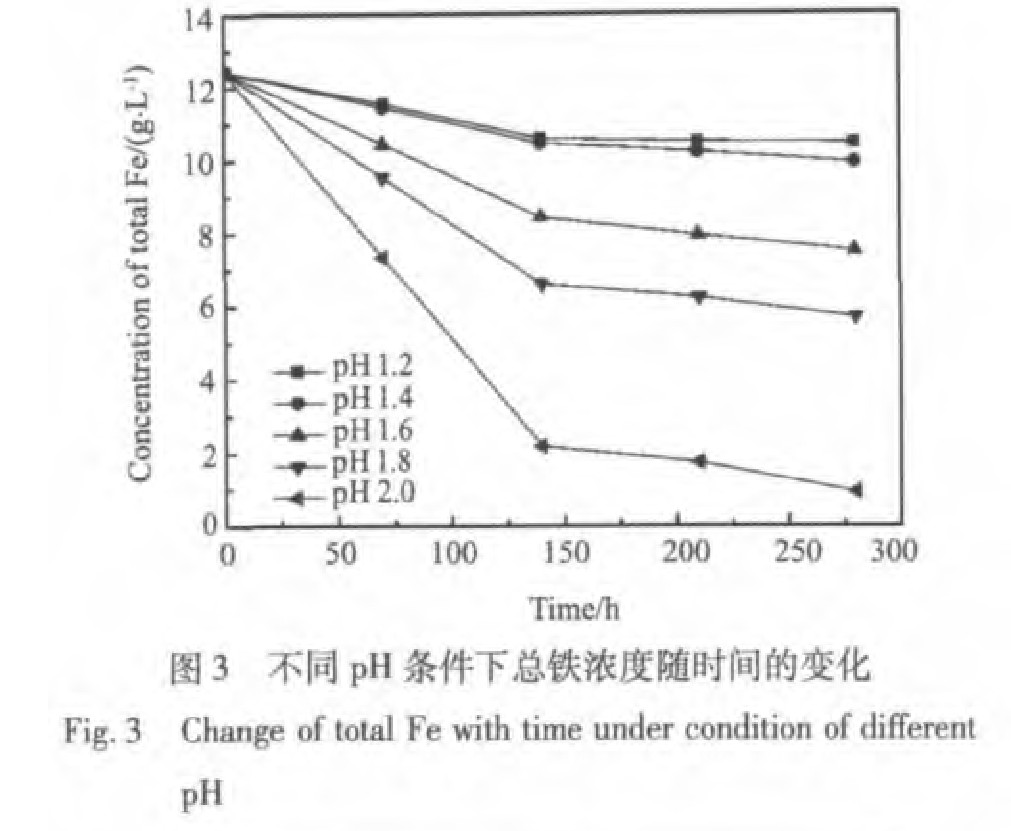
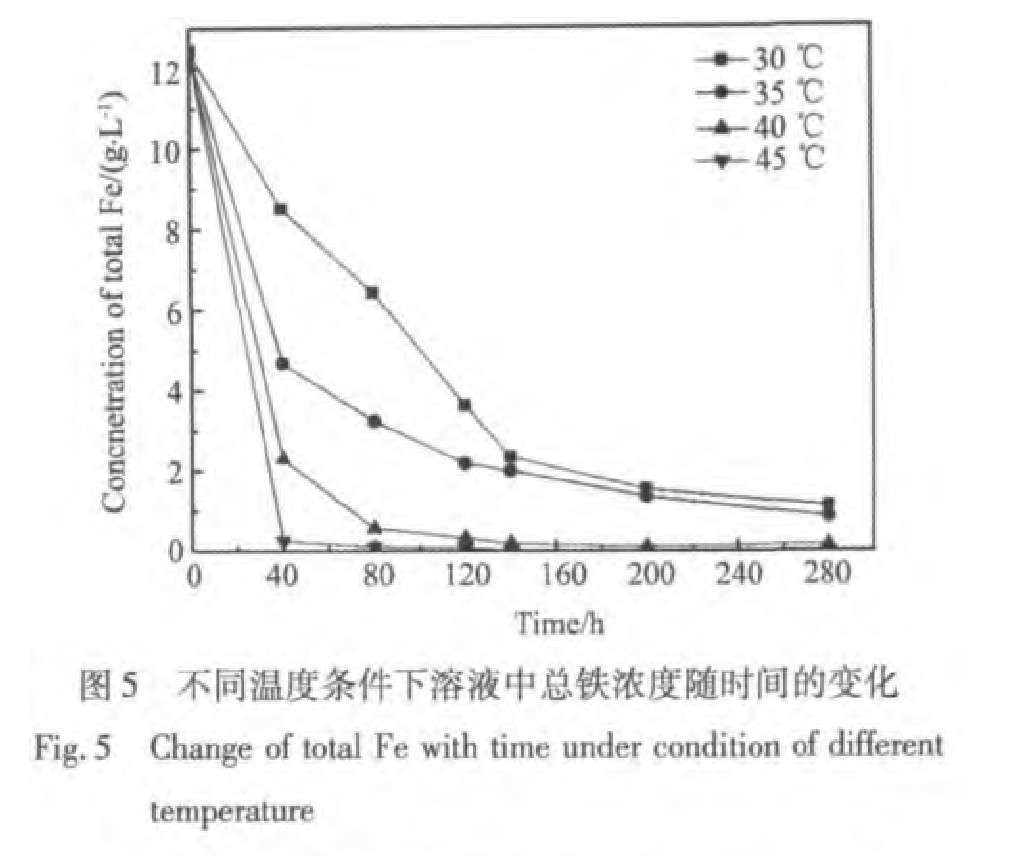
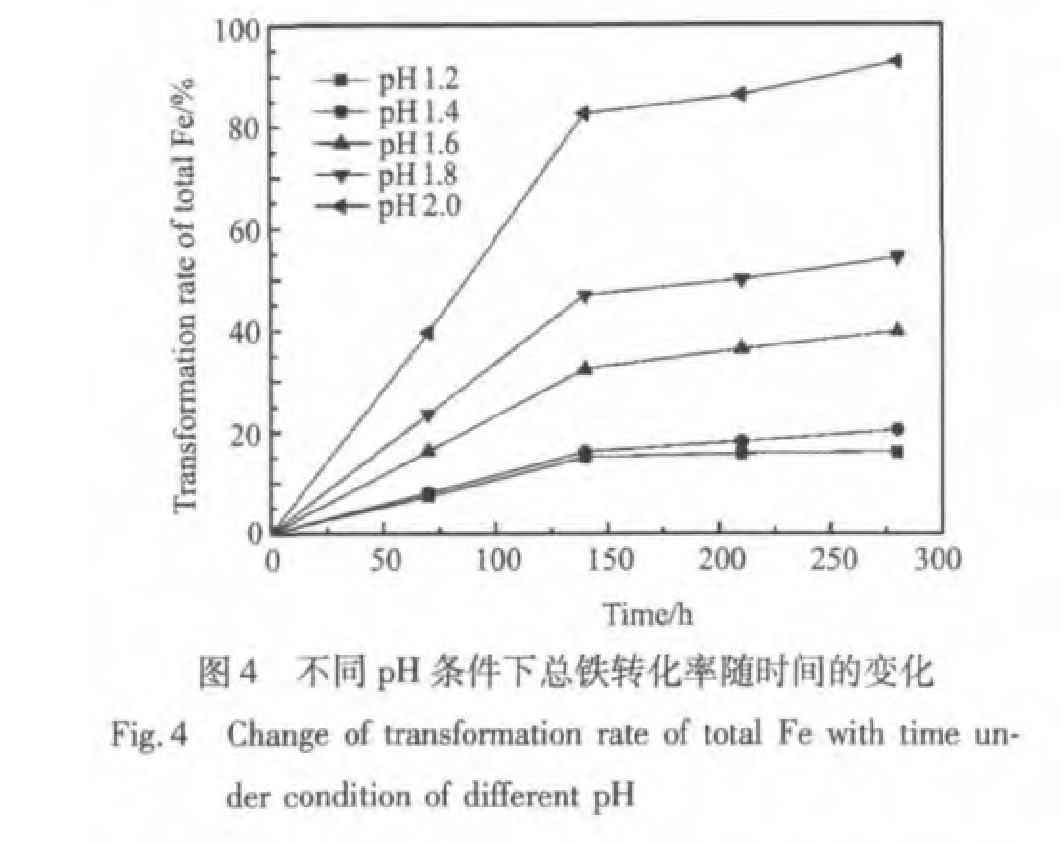
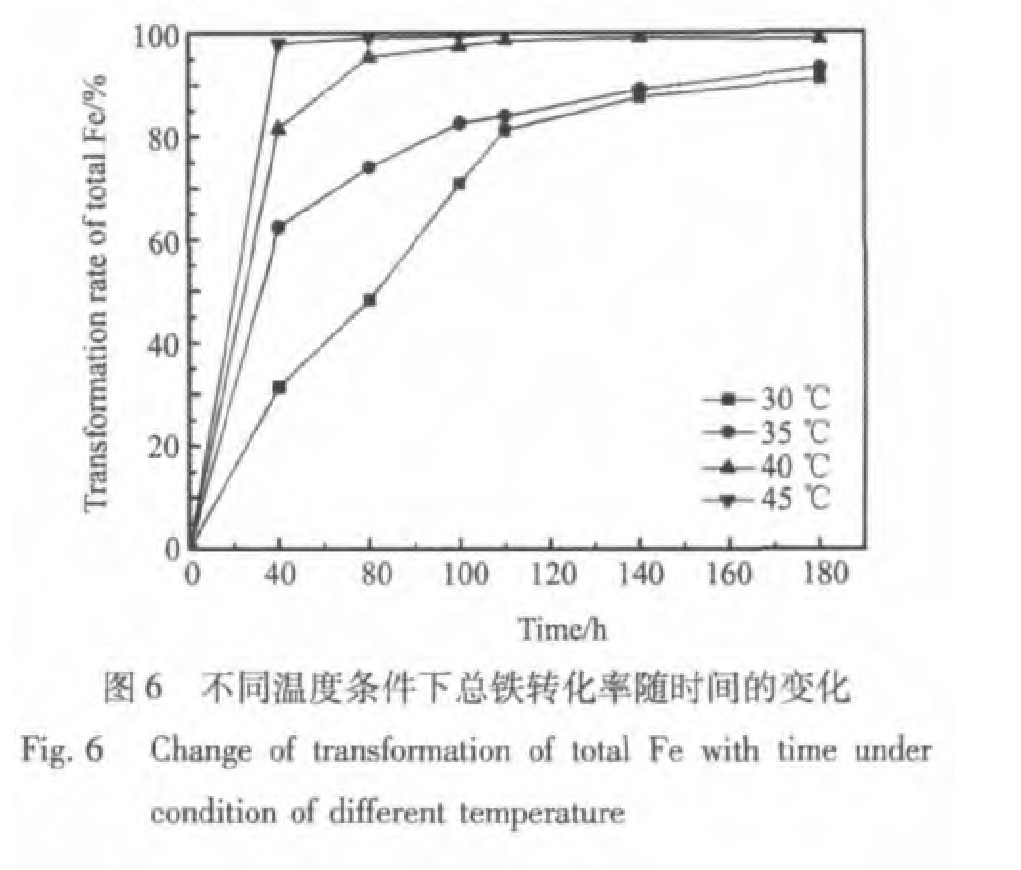
2.2.2 温度对铁矾形成的影响
在最佳pH为2.0条件下,考察不同温度30,35,40,45℃对生物成矾除铁效果的影响。不同温度条件下,溶液中总铁浓度及除铁率随时间的变化[13]如图5和6所示。
实验表明, 随着时间的延长, 溶液中总铁浓度逐渐降低, 且温度为40~45 ℃时, 溶液中总铁浓度比温度为30~35 ℃时降低速率快。 45 ℃时, 280 h 后, 溶液中总铁浓度可以降为6 mg·L-1。
从图6可以看出, pH为2时, 在细菌的作用下, 铁的转化率随着时间的延长而逐渐增加, 在40和45 ℃时, 铁的转化速率比在30和35 ℃时快, 且转化率高, 温度越高越利于生物成矾法除铁, 故确定45 ℃为最佳温度条件
取pH为2.0, 温度为45 ℃条件下的赭黄色沉淀物进行XRD分析, 分析结果如图7所示。
结果表明, 所得的赭黄色沉淀物为黄钾铁矾, 且沉淀物分散性能好, 易于沉淀过滤。
综上所述, 溶液pH和温度对黄钾铁矾的稳定性和沉淀率有重要影响, 在细菌作用下将溶液中亚铁氧化完全后, 生物成矾法沉淀除铁的最佳pH值为2.0, 最佳温度为45 ℃。 黄钾铁矾在形成过程中产生大量的酸, 酸度增高将降低铁的沉淀量和速率。 因此在试验过程中, 必须加入中和剂调节pH值, 中和剂应缓慢加入, 避免结晶过快, 颗粒太细, 或溶液局部酸度过低, 导致无定形Fe(OH)3沉淀生成
图7 沉淀物的XRD图
Fig.7 XRD diagram of sediment
2.3 多因素分析
本节将应用正交试验对生物成矾法除铁的条件进行多因素影响分析, 正交试验法是应用正交表的正交原理和数理统计分析, 研究多因素优化试验的一种科学方法。 它可以用最少的试验次数优选出各因素较优参数或条件的组合
2.3.1 实验设计
为提高沉淀除铁率, 本节对影响生物成矾法除铁的几个重要因素做了正交优化试验, 试验各因素水平设计如表2所示。 根据表2, 选择L16(45)正交表。
2.3.2 实验结果与分析
以除铁率为考核指标的试验结果与分析如表3所示。 (1) 确定主次因素顺序: 由表3可得, 极差R越大, 说明该因素的水平变化对试验结果指标影响越大, 因而该试验的主次因素顺序为CBA。
(2) 选取最优方案: 最优方案一般就是最优水平的组合, 所谓最优水平的组合就是指全体最优水平组成的试验条件; 当试验指标最大最好时, 以每列的Ki中数值最大的相应水平为最优水平; 本试验的最优水平组合为A4B4C2, 试验证明, 组合A4B4C2的除铁率为99.95%。
表2 正交实验设计
Table 2 Design of orthogonal experiment
Factors |
1 | 2 | 3 | 4 |
A Concentration of total iron/(g·L-1) |
20 | 30 | 40 | 50 |
B Inoculate quantity/% |
5 | 10 | 15 | 20 |
C Reaction time/d |
5 | 10 | 15 | 20 |
表3 以除铁率为考核指标的实验分析表(极差分析)
Table 3Experimental analysis table with iron removal rate as appraisal index(range analysis)
Test number |
Column number |
|||
A |
B | C | Experimental results iron removal rate/% |
|
| 1 | 1 | 1 | 1 | 98.370 |
2 |
1 | 2 | 2 | 99.940 |
3 |
1 | 3 | 3 | 99.270 |
4 |
1 | 4 | 4 | 99.930 |
5 |
2 | 1 | 2 | 99.930 |
6 |
2 | 2 | 1 | 98.740 |
7 |
2 | 3 | 4 | 99.830 |
8 |
2 | 4 | 3 | 99.520 |
9 |
3 | 1 | 3 | 99.960 |
10 |
3 | 2 | 4 | 99.960 |
11 |
3 | 3 | 1 | 98.560 |
12 |
3 | 4 | 2 | 99.940 |
13 |
4 | 1 | 4 | 99.130 |
14 |
4 | 2 | 3 | 99.970 |
15 |
4 | 3 | 2 | 99.970 |
16 |
4 | 4 | 1 | 99.630 |
K1 |
99.378 | 99.348 | 98.825 | |
K2 |
99.505 | 99.653 | 99.945 | |
K3 |
99.605 | 99.408 | 99.680 | |
K4 |
99.675 | 99.755 | 99.713 | |
R |
0.297 | 0.407 | 1.120 | |
(3) 画趋势图: 以除铁率为考核指标时各因素的影响趋势如图8所示。 由图8可看出, 溶液中总铁浓度越高越好, 菌种接种量以20%为最佳, 反应时间以10 d最佳, 确定最优水平组合为A4B4C2。
3 结 论
1. 在30~40 ℃, pH范围为1.4~2.0的条件下, 混合菌种经过3 d的细菌氧化可将溶液中的Fe2+氧化为Fe3+, 氧化率接近100%。
2. 在pH为2, 温度为45 ℃条件下, 溶液中的Fe3+在硫酸根, K+存在条件下水解成赭黄色高铁沉淀, 除铁率高达99.97%, 除铁后液含铁14.5 mg·L-1, 且所得的铁矾晶体粒径均匀, 分散性好。
3. 针对溶液中总铁浓度(A), 菌液接种量(B),反应时间(C)等3个因素设计了三因素四水平的正交试验, 考察各因素对生物成矾除铁率的影响, 确定了以除铁率为考核指标时的主次因素顺序及最优组合A4B4C2。
图8 以除铁率为考核指标时各因素的影响趋势图
Fig.8 Influence trend of the factors with iron removal rate as appraisal index
4. 针对复杂生物浸出液, 采用常温、 低pH条件下生物成矾法除铁, 具有除铁效果好, 能耗低, 流程短, 为生物浸出液体系净化除铁提供了一条新途径, 该生物除铁方法对生物浸出液中有价金属镍钴的后续萃取分离富集具有重要意义。
参考文献


